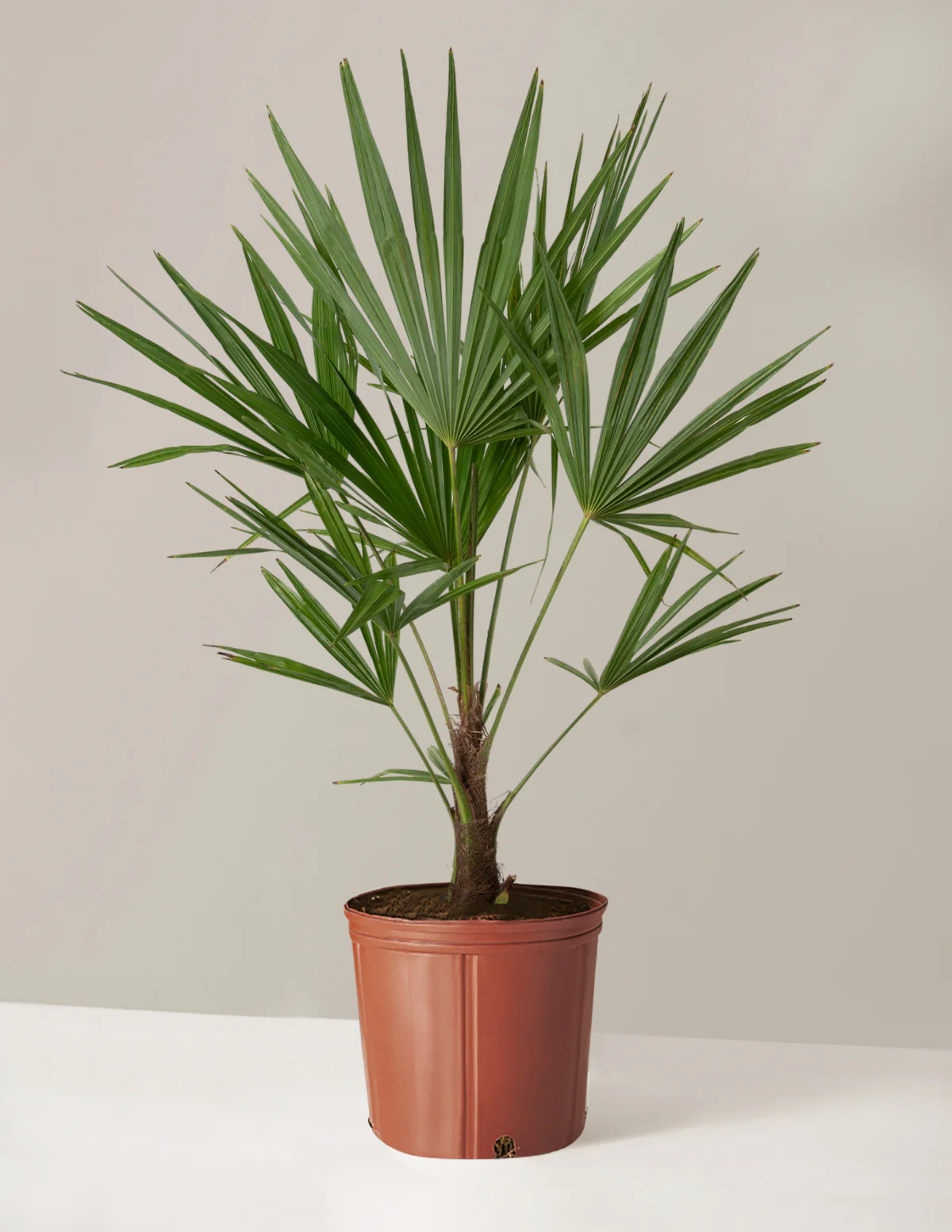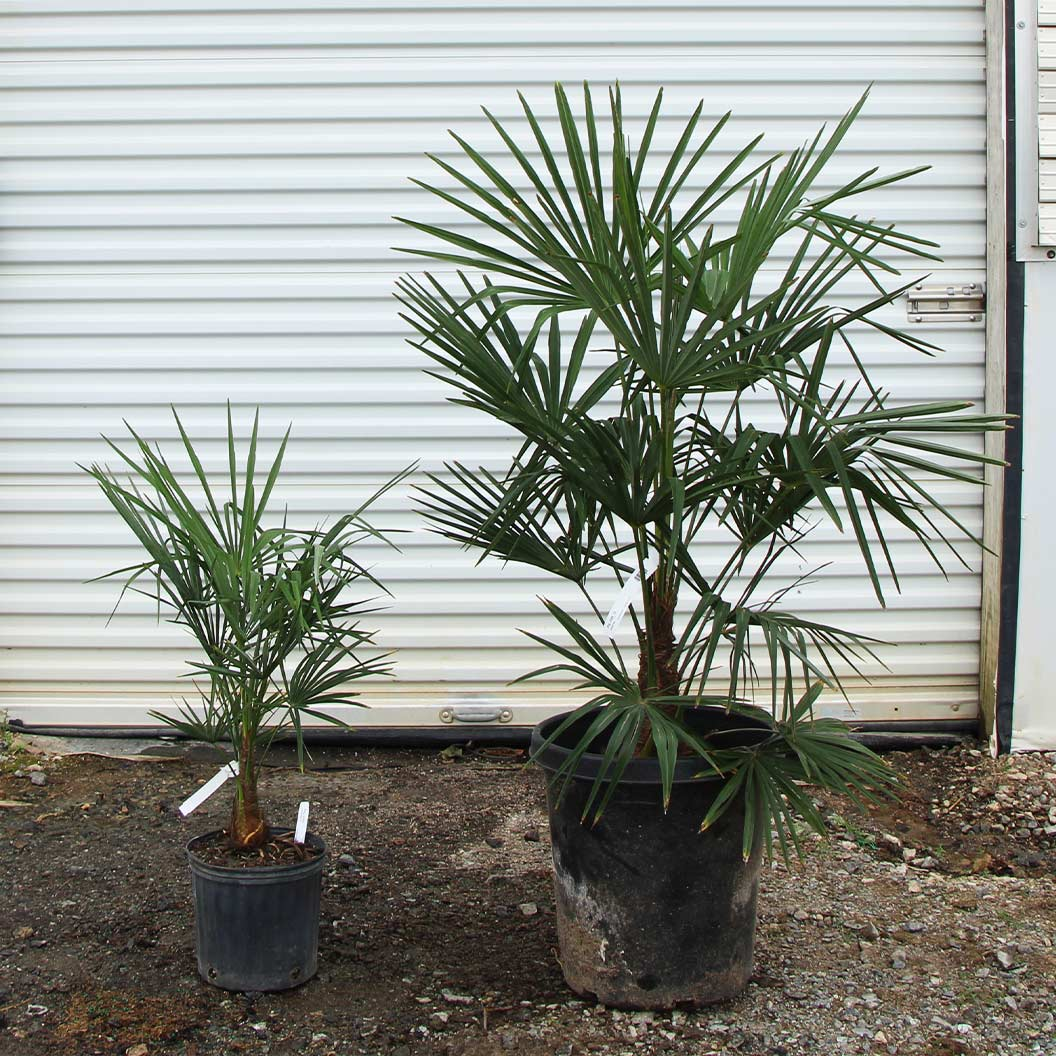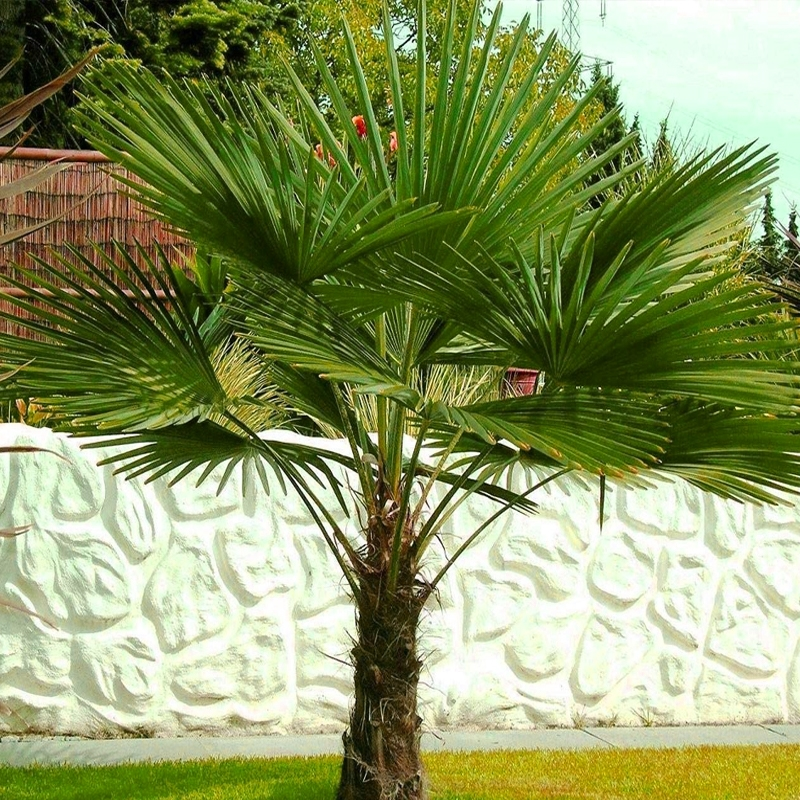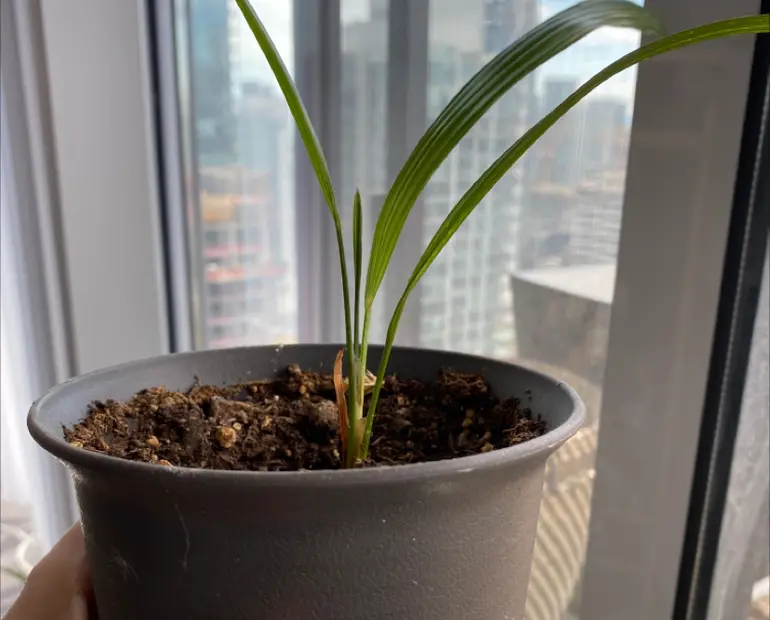- The windmill palm is an exceptionally hardy palm tree that adds a tropical look to gardens even in challenging climates.
- Native to East Asia, this palm’s cold tolerance makes it popular in temperate regions where traditional tropical palms struggle.
- Its fan-shaped leaves, sturdy fibrous trunk, and evergreen nature provide year-round beauty and wind protection for other plants.
- Windmill palms require well-draining soil, proper placement, and minimal care, making them low-maintenance and adaptable to various climates.
Creating a beautiful garden requires careful attention and management when growing plants. It can be challenging due to climate change. The windmill palm is a great option for gardeners who want to bring a tropical feel to their garden, even in tough weather conditions.
This is the most durable palm tree, able to withstand extreme weather while maintaining its tropical appearance. Its fan-shaped leaves and sturdy trunk give it the strength to survive conditions that are often difficult for other tropical plants.
Growcycle supports gardeners and plant lovers in growing and caring for various tropical plants. This article provides essential information on how to grow this cold-hardy palm in various climates.

Origin and History
The windmill palm originated in East Asia, primarily in China, Japan, and parts of the Himalayan region. It is native to mountainous areas where it grows at higher altitudes, making it more tolerant of cold temperatures than other tropical palm species.
The tree was first introduced to Western horticulture in the mid-19th century by British botanist Robert Fortune, after whom its scientific name, Trachycarpus fortunei, is partly derived.
Over time, it gained popularity worldwide as an ornamental tree for gardens and landscapes, especially in areas with temperate climates where traditional tropical palms cannot grow.
Botany of Windmill Palm
The windmill palm tree is a unique and hardy palm species known for its adaptability to various climates and its distinct botanical characteristics. Here is a look at its key botanical features:
Scientific Classification
- Kingdom: Plantae
- Family: Arecacae
- Order: Arecales
- Genus: Trachycarpus
- Specie: T. fortune
- Common Name: Windmill Palm, Chusan Palm, Chinese Fan Palm
- Plant Type: Evergreen outdoor tropical plant
Physical Characteristics
- Leaves: The windmill palm has large, fan-shaped leaves that are usually 3 to 4 feet wide. The leaves are divided into segments that look like a windmill, which is why they get their name. The leaves are dark green but may have a slight silver or blue color on the underside.
- Trunk: The trunk of the palm tree is narrow but strong. It is often covered with a rough, fibrous texture that helps it stay strong. The trunk usually grows up to 20 feet tall, but it can grow even taller in ideal conditions. The rough texture comes from the bases of the leaves that stay attached as the tree grows.
- Flowers: It produces small, yellowish flowers that grow in clusters on long stems. The flowers are not very noticeable but are important for the tree’s reproduction. Flowering happens in late spring or early summer.
- Fruit: After flowering, the tree produces small, dark blue or black fruits that are berries with seeds inside. Humans do not usually eat the fruit, but it may attract animals.
- Roots: Its fibrous root system helps it stay firmly rooted in the ground. It can grow in different soil types, including acidic, neutral, and slightly alkaline soil.
- Growth Habit: The tree grows slowly but steadily, especially in cooler climates where it is protected from strong winter winds. It is an evergreen tree that keeps its leaves all year round.
Types of Windmill Palm
There are mainly two types of windmill palms, though they can vary in appearance and hardiness based on their growing conditions:
| Type | Scientific Name | Native Region | Size | Leaf Size | Hardiness | Appearance |
| Chinese Windmill Palm | Trachycarpus fortunei | China, East Asia | Typically up to 20 feet, it can reach 40 feet | Large, fan-shaped leaves | Cold-hardy, withstands colder temperatures | Fibrous, rough trunk, large fan-shaped leaves |
| Wagner’s Windmill Palm | Trachycarpus wagnerianus | China | 10 to 15 feet tall | Smaller, more densely packed leaves | More cold-hardy, suitable for colder climates | Smaller, bushier appearance, compact |
Benefits of Growing Windmill Palms
Growing windmill palms offers several benefits, making them popular for gardeners and landscapers. Here are some of the key advantages:

- Cold Tolerance: One of the palm tree's biggest benefits is its survival ability in colder climates. It can tolerate temperatures as low as 10°F (-12°C), making it suitable for areas where most other palms wouldn't survive.
- Low Maintenance: Windmill palms are relatively easy to care for. They are hardy and can thrive in different soil types, from acidic to neutral. They require minimal pruning, and their slow growth means less frequent maintenance.
- Tropical Look: Despite being cold-hardy, they still offer a tropical appearance with their large, fan-shaped leaves and tall, elegant trunks. They can bring an exotic, tropical vibe to gardens, even in cooler regions.
- Attracts Wildlife: The tree’s small, dark fruits may attract wildlife, such as birds and small animals, adding biodiversity to the garden.
- Evergreen: As an evergreen plant, these plants retain their foliage year-round, ensuring the garden remains lush and green through all seasons.
- Wind Protection: Its strong, fibrous trunk and sturdy leaves can act as a windbreak, protecting other plants in the garden from harsh winds.
- Aesthetic Appeal: Its unique, fan-like leaves and rough texture make it look striking. It can serve as a focal point in gardens or landscapes and pairs well with other plants, providing contrast in textures.
- Environmental Benefits: Like all trees, these plants also help to improve air quality by absorbing carbon dioxide and releasing oxygen, contributing to a healthier environment. They also help reduce soil erosion by stabilizing the ground with their roots.
Grow Windmill Palm in Various Climates
Growing a cold-hardy plant can be successfully done in different climates by making a few adjustments. Here is how to grow this palm in various climates:
Growing Windmill Palms in Cold Climates
- Temperature Tolerance: These plants are known for their cold tolerance. They can survive temperatures as low as 10°F (-12°C) for short periods. However, they should be protected from extreme cold, especially when they are young and still establishing their roots.
- Winter Protection: Protecting the palm during winter is important in cold regions. Wrapping the trunk and leaves with burlap or other insulating materials can help shield the palm from freezing temperatures. Adding mulch around the base of the tree can also help keep the roots warm and prevent them from freezing.
- Location: In cold climates, the best place to plant this palm tree is in a sheltered area near a wall or fence that blocks strong winds. It should also be away from frost pockets, where cold air can settle. A location facing south is ideal, as it will receive the most sunlight and warmth throughout the day.
- Soil: Windmill palms need well-draining soil to prevent the roots from sitting in water, which can freeze and damage the tree. Avoid planting the palm in areas where water tends to collect, as this can lead to root rot or freezing in winter.
Growing Windmill Palms in Mild Climates
- Temperature: Windmill palms grow best in mild climates where the temperature stays between 20°F (-6°C) and 75°F (24°C) year-round. This range is ideal for healthy growth and allows the palm to thrive without extreme heat or cold stress.
- Soil: The palm prefers well-draining soil. It does not like sitting in water, so ensure the soil does not stay soggy. Soil that is slightly acidic to neutral is ideal, but the windmill palm is adaptable to various soil types.
- Sunlight: Windmill palms can grow in full sun or partial shade, but they perform best when they get about 6 hours of direct sunlight daily. A sunny location encourages strong growth and a healthy appearance.
- Watering: These palms need regular watering, especially during the growing season. However, it is important to avoid overwatering, as too much moisture can lead to root rot. The soil should be kept moist but not soggy.

Growing Windmill Palms in Hot and Dry Climates
- Heat Tolerance: Windmill palms can tolerate heat but may struggle in extremely dry conditions. They are best suited to areas with high summer temperatures but not consistently hot throughout the year.
- Soil: In hot, dry climates, the soil should retain some moisture and drain well. A mixture of loamy soil and organic material will help maintain this balance. Adding compost or mulch around the base can help keep the soil moist during dry spells.
- Watering: Windmill palms in hot climates will need extra watering to prevent the soil from drying out. However, it is important not to overwater, as the roots can suffer in waterlogged conditions. Water the tree deeply but allow the soil to dry out slightly between waterings.
- Sunlight: These plants can handle full sun, but some afternoon shade can help protect the leaves from burning in very hot areas. Planting the palm in a spot where it gets morning sun and afternoon shade can be a good solution in extremely hot climates.
Growing Windmill Palms in Tropical and Humid Climates
- Humidity: Tropical and humid climates are ideal for windmill palms, which thrive in warm, moist conditions. As long as they receive enough care, these palms grow quickly in such environments.
- Soil: In humid climates, the soil should be well-draining but able to hold some moisture. A mixture of loamy soil and organic matter is ideal. Although they are fairly adaptable, they prefer slightly acidic to neutral soil.
- Watering: Palm trees in tropical and humid climates need regular watering to moisten the soil, especially during dry periods. However, it is also important to ensure the soil drains well to prevent the roots from becoming waterlogged, which can lead to rot.
- Sunlight: Windmill palms thrive in full sun and partial shade. In very humid climates, it may be helpful to plant the palm in a spot that gets some afternoon shade, especially during the hottest parts of the day.
General Tips for Growing Windmill Palms
- Planting: When planting a windmill palm, dig a hole that is about twice the size of the root ball. The top of the root ball should be level with the surrounding soil. This helps the roots establish themselves without being too deep in the ground.
- Fertilization: Windmill palms can also take benefit from occasional fertilization, especially during their growing season. Use a slow-release fertilizer designed for palms, and apply it in spring or early summer when the tree is actively growing.
- Pruning: Regular pruning is important to keep the palm looking its best. Remove any dead or damaged leaves to prevent disease spread and improve airflow around the tree. However, avoid cutting healthy fronds unless absolutely necessary, as they help the palm grow strong.
Propagation of Windmill Palm
Propagation of this plant can be done in two main ways: seed propagation and offshoot propagation. Both methods take time and patience since Windmill Palms grow slowly. Here is how to do each method:

1. Seed Propagation
- First, collect seeds from mature plants. These seeds are small, dark, and look like berries. They appear after the palm flowers in late summer or fall. Once the fruit is ripe, carefully remove the seeds.
- Soak the seeds in warm water for 24 to 48 hours. This helps soften the outer shell and makes it easier for the seeds to sprout.
- Windmill palms are like soil that drains well and is slightly acidic. A good mix is peat, perlite, and sand. Fill small pots or a seed tray with this soil.
- After soaking, plant the seeds about 1/4 inch deep in the soil. Space the seeds apart to give them room to grow. Gently press the soil around the seeds to ensure they make good contact with the soil.
- Place the pots in a warm, sunny spot with temperatures between 70-85°F (21-29°C). Depending on conditions, the seeds can germinate in 1 to 6 months. Keep the soil moist but not too wet.
- Once the seeds sprout and small seedlings appear, leave them in their pots until they are strong enough to handle. After a few months, when the seedlings are big enough and have several leaves, they can be moved to larger pots or planted directly in the ground, depending on the weather.
2. Offshoot Propagation (Pups)
Windmill palms can also be grown from offshoots, called pups. These small shoots grow at the base of the main palm tree and can be separated to form new plants.
- Look for small shoots or pups growing at the base of the main palm trunk. These pups are tiny versions of the adult palm.
- Gently dig around the base of the pup and carefully separate it from the parent tree. Use a sharp knife or pruning shears to cut through the connecting roots, but be careful not to harm the pup.
- Use well-draining soil, just like for seed propagation. A good mix is sand, perlite, and peat moss. The soil should hold some moisture but also drain well.
- Place the pups in their own pots filled with prepared soil. Plant them at the same depth as they were in the ground. Water lightly, but avoid soaking the soil.
- Keep the pots in a warm, sunny spot with temperatures between 70-85°F (21-29°C). The pups will take time to grow roots, so make sure the soil stays moist but not waterlogged.
- After a few months, the pups should develop roots and start growing. Once they are well-established, they can be transplanted into the ground or into larger pots.
Common Problems and Solutions to Grow Windmill Palm
Here are some issues gardeners might encounter when growing windmill palms, along with their possible solutions:
1. Yellowing or Browning Leaves
Problem: If the plant leaves turn yellow or brown, it could be a sign of stress.
Solutions:
- Ensure the soil drains well to prevent waterlogging. Water the palm when the top few inches of soil are dry.
- Fertilize the palm with a balanced fertilizer to provide necessary nutrients, particularly nitrogen.
- If the palm is in full sun, try to provide some afternoon shade to prevent leaf burn.
2. Wilting or Drooping Leaves
Problem: Wilting or drooping leaves can indicate that the plant is not getting enough water or experiencing root stress.
Solutions:
- Water the palm deeply but ensure the soil is well-draining to avoid waterlogging.
- Check the soil for dryness or compactness. If necessary, consider aerating it.
- If root rot is suspected, remove the palm from its pot or ground, inspect the roots, and trim off any affected areas.
3. Pests and Diseases
Problem: Windmill palms can be affected by pests and diseases, which may cause damage to the plant.
Solutions:
- Inspect the palm regularly for pests. Treat the palm with insecticidal soap or a neem oil solution if pests are found.
- Remove and dispose of any infected leaves to prevent the spread of disease.
- For fungal issues, apply a fungicide according to the manufacturer's instructions.
Summary
The windmill palm can thrive in different environments and needs little care to grow. It also brings an elegant look to tropical landscapes. The tree can adapt and grow well in tough conditions, like cold weather. Its leaves are sometimes used to make roofs, mats, brushes, and brooms because of the strong fibers in the leaves.
Growcycle offers various care guides for growing indoor plants in different conditions. It also provides different gardening tools and techniques for growing healthy plants.
Disclaimer: This material is for informational purposes only and should not be relied on for legal, medical, financial, or any other form of professional advice.

